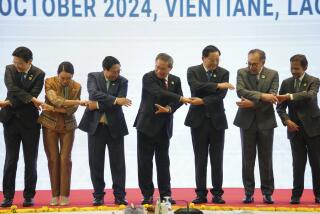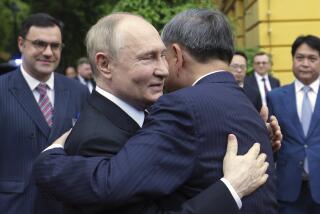Thailand, Other U.S. Allies Report Booming Economies : Some of Dominoes Fell--but Others Did Not
BANGKOK, Thailand — In 1959, years before the large-scale U.S. military commitment in Vietnam, President Dwight D. Eisenhower warned, “The loss of South Vietnam would set in motion a crumbling process that could, as it progressed, have grave consequences for us and for freedom.”
That was the “domino theory,” first advanced by Eisenhower and later embraced by Presidents John F. Kennedy and Lyndon B. Johnson.
And, as of April 30, 1975, Communist authorities ruled in Saigon, soon to be renamed Ho Chi Minh City, and in the Cambodian capital of Phnom Penh, where a U.S.-supported government had fallen two weeks earlier. Before the year was out, the Communists would have full control of the government of Laos as well--all of what had once been French Indochina.
However, the fear that other governments in Southeast Asia would be toppled has proved to be unfounded. A decade of change in the region bears more resemblance to the pyramiding business of a Monopoly game than to dominoes.
Thailand, which many domino theorists predicted would be the first to fall, has joined its partners in the Assn. of Southeast Asian Nations in a remarkable economic surge. The six ASEAN countries, as a bloc, have become the fifth-largest trading partner of the United States, and they also do a burgeoning business with Japan. Their economies grew at an average annual rate of 7% through the 1970s.
The recession of the early 1980s slowed Southeast Asia’s rapid economic growth. Still, by comparison, Vietnam, Cambodia and Laos have barely left the starting gate.
The Hanoi government reported a gain of 6% in gross domestic product in 1983 but, unlike the non-communist countries in the region, its economy is not geared to trade with the West and its foreign reserves are barely sufficient for needed imports. Life is Spartan, particularly in the north.
Analysts point to several reasons for the turn of events in Southeast Asia and the shortcomings of the domino theory:
--Soon after their victories of 1975, the Communists fell to fighting among themselves, draining the momentum of the movement and eventually drying up Chinese support for a Marxist insurgency in Thailand. The Vietnamese are caught in conflict with China and with the Communist Khmer Rouge of Cambodia. China and Cambodia both have antipathy toward the Vietnamese (and vice versa), an attitude that predates the Marxist fraternity of this century.
--The passive U.S. policy toward the region in the years immediately after the war--a product of the so-called Vietnam syndrome--allowed or forced the leadership of the non-communist countries to become more self-reliant.
The result has been a growing political maturity and stability, although it is uneven and in some places--Indonesia and Singapore, for instance--rests on longtime rule by a single leader. (The Philippines, where President Ferdinand E. Marcos has held power for two decades, has ASEAN’s most troubled economy and strongest insurgency.)
--The tide of refugees from Vietnam, Laos and Cambodia, which washed the shores of all the Southeast Asian countries in the early 1980s, has given the Communist countries a black eye. “So many refugees coming out,” said Khien Theeravit, director of the Institute of Asian Studies at Bangkok’s Chulalongkorn University. “People have seen them on television. Perceptions change.”
--There is also the question of Vietnamese intentions outside Indochina. Khien was asked whether he thought the Vietnamese wanted to invade Thailand after their conquest of the south in 1975, and he replied: “Not then, not now.” Only a minority of analysts suggests that the Vietnamese want control of the entire Mekong River basin, which would include parts of northeastern Thailand.
In general, American policymakers like the trends for Southeast Asia and the rest of the Pacific.
“A sense of Pacific community is emerging,” Secretary of State George P. Shultz told the Senate Foreign Relations Committee earlier this year. “There is an expanding practice of regional consultation, and a developing sense of common interest in regional security. In this sense, a decade after Vietnam, the United States has more than restored its position in Asia.”
Adm. William J. Crowe Jr., commander of U.S. forces in the Pacific, agrees.
“Having experienced that (Vietnam) drama at first hand,” he said recently, “I would have predicted that it would take a quarter of a century to recoup. Fortunately, that has not been the case.”
Not all the developments of the decade have been positive from Washington’s point of view, however. A major concern is the growing Soviet fleet in the Pacific and its use of the American-built facilities at Cam Ranh Bay in Vietnam, 2,200 miles south of Vladivostok, the fleet headquarters.
Crowe told the Senate Armed Services Committee that he believes the Soviets “are there to stay and plan to use this facility on a routine basis for the indefinite future.”
An estimated 20 long-range Bear and Badger aircraft, 30 ships operating in the South China Sea and a recently deployed dozen MIG-23 fighters have made Cam Ranh Bay a forward base for reconnaissance and sea power in an area of the Pacific formerly beyond the Soviets’ reach on a regular basis.
The Soviet Union also continues to send Vietnam about $2 billion a year, underwriting part of the cost of the million-strong Vietnamese army and its operations in Cambodia.
China, the third big power in the region, spends just a fraction of that as the major bankroller of Cambodian rebels against Vietnam’s military occupation and the Hanoi-installed government of Premier Heng Samrin in Phnom Penh.
The ASEAN countries themselves continue to have differences. A key problem is that their main exports--highly industrial and mercantile Singapore excepted--are competing commodities. As a result, trade within the ASEAN countries accounts for only 15% of the total exports of the six nations: Thailand, Malaysia, Singapore, Indonesia, the Philippines and Brunei.
They also have problems with their Western trading partners, often raising the question of protectionism.
Politically, however, ASEAN has rallied around the issue of Cambodia and support for the resistance coalition. Thailand, whose border is a battleground, is leading the way.
A Testing Point
Cambodia has also become a testing point for the big powers:
--The United States has supported the ASEAN stand--a call for a phased withdrawal of the estimated 160,000 Vietnamese troops, international peacekeeping and relief efforts, temporary political control by the Khmer Rouge and non-communist resistance factions plus the Heng Samrin regime--and, eventually, free elections.
The supportive American policy “strengthens these (ASEAN) governments,” a Western diplomat said. “A more aggressive policy might upset them.”
The ASEAN countries, however, have called on Washington to increase its support of the Cambodian resistance, which currently consists of “humanitarian” aid to the non-communist factions. ASEAN officials have been heartened by an amendment sponsored by Rep. Stephen J. Solarz (D-N.Y.) and approved by the House Foreign Affairs Committee that would send $5 million to the Thai government to aid the resistance forces in ways it sees fit, possibly including arms.
The Reagan Administration opposes American arms aid for the Cambodian resistance.
--The Soviet Union, while publicly supporting a political settlement in Cambodia and apparently eager to maintain cordial relations with the countries of Southeast Asia, continues to back the Vietnamese position.
Pursuing this policy has led the Soviets into a diplomatic minuet. Deputy Foreign Minister Mikhail S. Kapitsa, on a swing through the region, was asked by reporters about Thai charges that Vietnamese troops had entered Thai territory in their dry-season offensive against the Cambodian resistance, which Hanoi had denied.
“I don’t say the Thais are lying but I say the Vietnamese were not lying,” Kapitsa replied.
Chinese Swing
China’s position on Cambodia and in Southeast Asia, which has traditionally been a region of Chinese influence, has swung from support for Vietnam during the war to strong opposition and to support for the Cambodian resistance, primarily the Khmer Rouge.
“They have learned to make a profit from the situation,” Khien, the Thai Asian specialist, said.
“They are looking for friends and cooperating economically,” the Western diplomat said.
The diplomat attributed the Chinese policy more to its economic outlook under the leadership of pragmatist Deng Xiaoping than to a desire to counter Soviet moves in the area.
“Under Mao, the Chinese were more interested in ideology and less so in trade,” he said. “That has changed.”
Indonesia and some other Southeast Asian nations with large Chinese minorities take a more suspicious view of Peking’s political intentions, and its potential for economic domination of the region as China modernizes its economy.
Meanwhile, the fourth nation with influence in the region, Vietnam--whose leaders used to say that time was on their side--can see the steady progress of its neighbors.
Hanoi, too, talks of a Cambodian settlement, but on terms that have so far been unacceptable to the ASEAN countries: withdrawal of its forces and elections but with no role in government for Khmer Rouge leaders, whom ASEAN uncomfortably finds acceptable for now as the largest and best-armed faction opposing Hanoi. The Vietnamese proposal also calls for just one ticket, the Communist Party, on the ballot, although other candidates could run as independents.
Vietnamese officials have publicly suggested that the United States could play a useful role in the region. This is often interpreted as a renewed bid, 10 years after the war, for diplomatic relations between Hanoi and Washington, perhaps out of concern over the prospect of improved ties between Peking and Moscow. But many diplomats say it is merely a ploy to divide the ASEAN nations on the Cambodian issue.
U.S. diplomatic relations could ease Hanoi’s pain from economic sanctions and its cutoff from U.S.-dominated international lending institutions. The Soviet Union does not offer those sorts of economic possibilities.
Still, even increased Western aid might not invigorate the Vietnamese economy, which has yet to make the jump from a wartime footing to national development.
And a diplomatic breakthrough between the United States and Vietnam is considered out of the question without progress toward recovering the bodies of U.S. servicemen still missing and a settlement on Cambodia, and for now all sides seem reluctant to give ground on that battlefield.
THE DOMINOES OF SOUTHEAST ASIA 1. CAMBODIA
Having survived a brutal, four-year Khmer Rouge reign in which at least 1 million people died, Cambodia has been governed since early 1979 by a Vietnamese-installed regime and occupied by an estimated 160,000 of Hanoi’s troops.
2. LAOS
Least developed of the Indochina nations, Laos is also under the thumb of Hanoi and its 45,000 occupying troops. Like Cambodia, it is involved in border hostility with Thailand, a U.S. ally.
3. THAILAND
America’s key surviving ally in Indochina, Thailand, with 52 million people, is a constitutional monarchy. Bangkok has replaced Saigon as a Western point of entry. About 230,000 Cambodian refugees and guerrillas have taken sanctuary in Thailand.
4. INDONESIA
A vast Indian Ocean archipelago of 170 million people, 90% of them Muslim, Indonesia for nearly 20 years under President Suharto has been a bulwark of anti-communism in Southeast Asia.
5. MALAYSIA
A nation split geographically as well as ethnically, Malaysia is divided by dissension between the dominant Malays and minority Chinese. It has suppressed an intermittent Communist insurgency.
6. SINGAPORE
A prosperous, efficient and puritanical city-state ruled by Prime Minister Lee Kuan Yew for a quarter century, Singapore provides one of Asia’s highest living standards for its 2 1/2 million people.
7. PHILIPPINES
Ruled by President Ferdinand E. Marcos since 1965, often under martial law, the Philippines remains a U.S. military mainstay. Leftist and Muslim rebels and a growing democratic opposition challenge Marcos’ regime.
8. BRUNEI
Independent since Jan., 1984, and the newest member of the Assn. of Southeast Asian Nations, the sultanate lies on the north coast of Borneo. The Muslim state has oil resources and few people.
More to Read
Sign up for Essential California
The most important California stories and recommendations in your inbox every morning.
You may occasionally receive promotional content from the Los Angeles Times.










